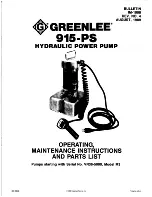
408-6788
10
of 12
Rev
L
9.1. Daily Maintenance
1. Remove dust, moisture, and other contaminants
from the tool with a clean brush or a soft, lint-free
cloth. Do NOT use objects that could damage the
tool.
2. Make sure that the proper retaining pins are in
place and are secured with the proper retaining
rings.
3. Make certain that all pins, pivot points, and
bearing surfaces are protected with a THIN coat of
any good SAE 20 motor oil. Do NOT oil excessively.
4. When the tool is not in use, keep the handles
closed to prevent objects from becoming lodged in
the crimping chambers and store the tool in a clean,
dry area.
9.2. Periodic Inspection
Regular inspections should be performed by quality
control personnel. A record of scheduled inspections
should remain with the tool and/or be supplied to
supervisory personnel responsible for the tool. Though
recommendations call for at least one inspection per
month, the inspection frequency should be based on
the amount of use, working conditions, operator
training and skill, and established company standards.
These inspections should be performed in the
following sequence:
A. Visual Inspection
1. Remove all lubrication and accumulated film by
immersing the tool (handles partially closed) in a
suitable commercial degreaser that will not affect
paint or plastic material.
2. Make certain that all retaining pins are in place
and are secured with retaining rings. If
replacements are necessary, refer to Section 10,
REPLACEMENT AND REPAIR.
3. Inspect crimping chambers for pitted or chipped
surfaces.
4. Close the tool handles until the ratchet releases,
then allow handles to open freely. If they do not
open quickly and fully, the spring is defective and
must be replaced. Refer to Section 10,
REPLACEMENT AND REPAIR.
B. Gaging the Crimping Chambers
This inspection requires the use of a plug gage
conforming to the dimensions listed in Figure 17. TE
does not manufacture or market these gages. To gage
the crimping chambers, proceed as follows:
1. Insert Die Set 312253-1 as described in
Section 5, TOOL SETUP. Do NOT insert the locator.
2. Close the tool handles until the ram touches the
stop surfaces. Refer to Figure 17.
Figure 17
3. Align the GO element of the gage with the
crimping chamber so that the top and bottom of the
gage align with the surfaces of the die inserts and
ram.
4. Push the element straight into the crimping
chamber without using force. The GO element must
pass completely through the crimping chamber as
shown in Figure 17.
GAGE ELEMENT DIAMETERS
GO
NO-GO
15.915-15.920 [.6266-.6268]
16.078-16.083 [.6330-.6332]
Suggested Plug Gage Design
63.5 [2.5] (Typ)
6.35 ±0.25 [.25 ±.01]
12.7 [.50]
12.7 [.50]
NO-GO
GO
Inspection of Crimping Chamber
Top of Ram
Crimping Chamber
16.0 ±0.08
[.630 ±.003]
Stop
Surface
GO Element
NO-GO Element
Crimping
Chamber
Crimping
Chamber
12.2 ±0.25
[.48 ±.010]
GO element must
pass completely
through the
crimping chamber.
NO-GO element may
enter partially, but must
not pass completely
through the crimping
chamber.
Die Inserts
312253-1
(Required)
GO/NO-GO
Gage































